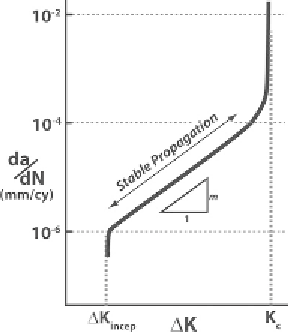Biomedical Engineering Reference
In-Depth Information
d
a
test is that it is relatively simple to perform. However,
it only provides information about the total lifetime
associated with a given set of test conditions; it
provides little insight into the contribution of cycles
devoted to initiating the crack/flaw versus the cycles
devoted to propagating the crack to fracture or to the
kinetics of stable fatigue crack growth (FCG).
d
N
¼ CDK
m
where the coefficient,
C
, and the exponent,
m
, are
dependent on intrinsic (material) and extrinsic (test
conditions) factors. In regime III, the curve again
becomes nearly vertical as unstable fracture is
approached.
5.2.4 Fatigue Crack Propagation
Unlike the
S
e
N
total life method, fatigue crack
propagation (FCP) studies provide insight into the
kinetics of FCG from an initiated crack
[12,15,16]
.In
the FCP test, it is assumed that linear elastic fracture
mechanics conditions apply such that the stress state
at the crack tip is described by the stress intensity
factor
K
. As with the fracture toughness test, the FCP
test is often conducted under mode I loading, using
a notched and precracked CT specimen, with
a constant cyclic stress
[21]
.
5.2.5 Notches
The presence of a stress concentration, generically
referred to as a notch, alters the stress state in the
vicinity of the notch and may increase the tendency
for brittle fracture (as opposed to gross yielding) in
potentially four ways: by introducing high local
stresses, by creating a triaxial stress state ahead of the
notch, by causing high local strain hardening, and by
magnifying the strain rate locally
[22]
. As long as no
local yielding at the notch root occurs, the stress at
the notch root is defined as follows:
K
min
) can
be determined based on the minimum and maximum
applied cyclic stresses, the specimen geometry, and
the current crack length. The crack length is peri-
odically recorded as a function of the number of
cycles. For a constant applied cyclic stress,
DK
(
K
max
s ¼ k
t
S
where
k
t
is the elastic stress concentration factor
(which is not a function of material) and
S
is the
nominal stress across the area
[14]
. For an idealized
purely elastic material without yielding, Neuber
[23]
derived the stress distributions in the notch solely
based on the material properties and the geometry of
the notch.
Depending on the ability of the material to undergo
plastic deformation in the vicinity of the notch, the
material can either demonstrate a tendency toward
brittle fracture (notch weakening) or failure after
yielding at a stress greater than the unnotched yield
stress (notch strengthening)
[22]
. When a notched
specimen is loaded, there is a triaxial stress state at the
notch root, which is due to the stress concentration
effect of the notch (
Fig. 5.4
). In ductile materials, once
the net section stress (the average stress applied to the
reduced cross-section) reaches the material yield
stress, the material in this section attempts to plasti-
cally deform. At this time, the magnitude of the stress
concentration factor is lowered because of the redis-
tribution of stresses caused by local plastic flow
[24]
.
However, the notch root material also seeks to contract
(due to incompressibility in plastic flow) but is con-
strained by the bulk of the material that is still expe-
riencing elastic stresses. The resulting tensile stresses
in the tangential and radial directions make it neces-
sary to increase the axial stress to initiate plastic flow.
DK
will
increase as the crack length increases. FCP results are
plotted on log
e
log axes with the crack growth per
cycle, d
a
/d
N
, on the
y
-axis and
DK
on the
x
-axis.
Three regimes can often be identified (
Fig. 5.3
): In
regime I, the curve is nearly vertical, and it is
generally considered to identify a
DK
below which
FCG is not expected to occur. Regime II is referred to
as the Paris regime for P.C. Paris
[12,15,16]
, who first
identified that this regime could be described by
a power law relationship:
Figure 5.3
Representative schematic of FCP behavior.
Courtesy of Ref.
[42]
.


